French Terms
John McCabe
Note: This listing of French terms associated with the oyster
business is not to be considered a definitive list on the topic.
It may also contain some terms which are no longer commonly used.
I'm still looking for someone at IFREMER or a French oysterman
who might speak English and be kind enough to help me review
and possibly expand this listing.
Ambulance (d'Huitres)
The term describes a shallow rectangular cultivation cabinet,
usually made of wood. A matching wood frame with meshing of some
sort serves as a lid. The box is placed into the shallow tidal
zone and serves as a nursery for baby oysters which have been
damaged during their removal from collection tiles. The meshing
allows nutritious water in and keeps predators out. Historically,
the use of this type of cultivation box is associated with the
Arcachon Bay.
Affinage
"Affinage" means "refinement" and describes
an additional step in the French cultivation process. Usually
oysters of marketable size are collected and placed into a special
feeding environment. This could possibly be a refinement compound
(called a "claire") or a certain river estuary. The
duration of 'affinage" can vary from weeks to months. Most
areas in France have strict rules associated with 'affinage".
See also report "Affinage"
Au grand air
Conditioning of the abductor muscles of oysters in special basins
before shipment. In the course of about 10 days, the water level
is lowered and raised artificially to teach the oysters to forget
the rhythm of their natural tidal environment. Once they get
used to being exposed to the 'fresh air" (or "grand
air"), they will stay shut longer during transport and retain
their freshness better. Also known as "trompage".
Belon (Bélon)
By far the most famous name in the oyster world. It designates
European oysters which have been refined in the estuary of the
Belon River in southern
Brittany.
Bourriche
A special basket with a lid, often made of thin wood slats or
wicker, for shipping oysters. The size varies. Depending on size,
some can hold 100 - 144 oysters. A mandatory certificate indicating
origin, quantity, size, and weight is attached.
Calibres
French weights and measures system for oysters. Pacific oysters
and European oysters are rated differently:
Pacific oysters (Crassostrea gigas)
| Nummer |
5 |
4 |
3 |
2 |
1 |
0 |
| Abb. |
P |
M |
M |
G |
TG |
TG |
| Weight |
30-45g |
46-65g |
66-85g |
86-110g |
111-150g |
150g+ |
Abbreviation key:
"P": Petit (small)
"M": Moyen (medium)
"G": Grand (large)
"TG": Très Grand (very large)
Source:
http://www.huitresmarennesoleron.info
European oysters (Ostrea edulis)
| Nummer |
4 |
3 |
2 |
1 |
0 |
00 |
| Abb. |
P |
M |
M |
M |
G |
TG |
| Weight |
40g |
50g |
60g |
75g |
90g |
100g |
Particularly large European oysters: "000" = 110g,
"0000" =120g, "00000" = 150g ... and more.
Cavaliers
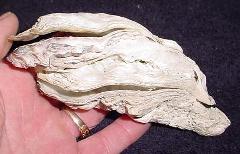 Younger oysters
which grow on the flat (right) valve of marketable oysters. As
they often can't be removed without destroying one or the other
oyster. French growers find them undesirable. American growers
sometimes call these oysters "jockeys".
Younger oysters
which grow on the flat (right) valve of marketable oysters. As
they often can't be removed without destroying one or the other
oyster. French growers find them undesirable. American growers
sometimes call these oysters "jockeys".
Captage
Captage describes the deliberate effort of oystermen to capture
oyster babies on special collectors. Tile, PVC-pipe, wooden posts,
oyster shells etc. can be used. Arcachon
and Marennes-Oléron
are of great commercial importance in this endeavor. See also
report on "Captage".
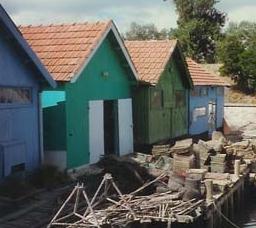 Chai à trier
Chai à trier
A typical French work building for oyster growers. At times it
may double as living quarters as well. The Marennes-Oléron
area is particularly famous for this type of building. Rows of
work buildings, each building painted in a different color, creates
a beautiful sight.
Chaulage
Chaulage
describes a special process of coating ridge tiles with a quicklime
mixture. The tiles are used to capture oyster babies. See also
report on "Captage".
Claires
A generic term describing large water basins used in the cultivation
process of oysters. Claires can have a number of important functions.
Marennes-Oléron
is particularly famous for its claires. See also the report on
"Claires"
as well as "Affinage".
Collecteurs
Materials used specifically for the capture of oyster babies.
The most famous "collecteurs" are coated ridge tiles.
See "captage" and report on "captage"
Concession
A surveyed oyster bed leased from the respective province or
French government.
Conchyliculture
The term describes anything and everything associated with the
cultivation of shellfish.
Coursières
Canals of varying size which aid in the filling and draining
of cultivation compounds.
Couteau à huître
Oyster knife
Creuse
Colloquial term for the Pacific oyster (Crassostrea gigas). Another
colloquial name for the Pacific oyster is "Japonaise".
Since about the mid 1970s, the Pacific oyster is by far (more
than 90%) the principal oyster cultivated and sold in France
(or Europe for that matter). For abot 100 years before that time,
the Portuguese oyster (Crassostrea angulata) was the principal
oyster grown and traded. During that century, it was also called
a "creuse" (or "Portugaise"). Between the
years 1968 and 1972, an oyster disease devastated the Portuguese
oyster in European waters.
Crible
A mechanical sieve or strainer which helps sort different oyster
baby sizes.
Culture des huîtres
Oyster cultivation.
The three main cultivation methods used in France are:
* Ground cultivation: "Culture au sol" in the inter-tidal
or sub-tidal zone. "En eau profonde" usually describes
cultivation in deeper water in the sub-tidal zone with boats
and dredges.
* "Rack and bag": "Surélevé"
("raised higher").
Oysters in special synthetic mesh bags (called "poches")
are grown out on steel racks in the tidal zone.
* Suspended cultivation: "Suspendu" or "Elevage
sur cordes".
Describes a number of techniques such as synthetic mesh cages
hanging from rafts or floats (European oyster). "Elevage
sur cordes" describes what we call "longline cultivation".
While in American cultivation the "longlines" with
oysters are usually stretched out across a series of posts horizontally,
they hang vertically in the French region "Bassin de Thau"
from wooden racks. See also "Mediterranean".
Dégorgeoir
The term "dégorgeoir" or "bassin dégorgeoir"
usually describes a shallow rectangular basin made of concrete.
It accomodates many steel or plastic baskets with oysters, which
are filtering clear water to expell any kind of impurities (sand,
mud...) and will soon be shipped. These basins are another form
of "claire".
Dédoublement
"Dedoublement" is an important (and tedious) step in
the "rack and bag" cultivation process, whereby the
contents of a mesh bag full of oysters ("poche') are removed
and redistributed into two or three new mesh bags (or "poches").
Over time, all the oysters in a "poche" naturally grow
out and this mesh bag gets increasingly cramped for space. This
encourages shell deformities and also compromises the oysters'
ability to feed. "Dédoublement" or "parting
out" the "poche" simply gives the oysters the
necessary "elbow room" to live and grow out favorably.
Détroquage
"Détroquage" describes separating oyster babies
from a substrate such as coated tiles. The traditional hand method
requires much skill. Mechanical equipment is also used for détroquage.
See also report on "Captage".
Gravette
Traditional name for European oysters (Ostrea edulis) from the
Arcachon Bay. Alternative colloquial name for European oysters
is "Plates".
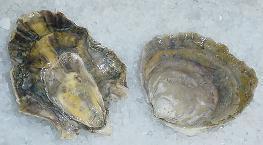 Huîtres
Huîtres
Oysters.
Only two kinds are found in French fish markets: the Pacific
oyster and the European oyster. They are easily qualified as
one or the other. The Pacific oyster tends to be oval with a
roughly ribbed shell. One half of the shell looks distincly "hollowed
out" or bellied, while the other looks rather flat like
a lid. If the sign says "creuse" (which means "hollowed
out") it's definitely a Pacific oyster. The European oyster
looks rather flat and often (hardly always) somewhat round. The
shell looks comparatively smooth. If the sign says "plate"
(which means "flat") it's definitely a European oyster.
If all else fails, the price tag will often tell the difference,
as the European oyster will cost twice (or possibly three times)
as much as the Pacific oyster. Inset image: The oyster on
the left is a Pacific oyster. The oyster on the right is a European
oyster.
Japonaise
See "Creuse".
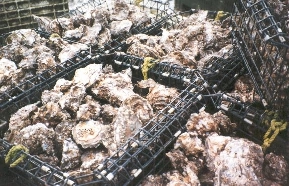 Mannes
Mannes
Practical work baskets (often square or rectangular) made of
steel or plastic which facilitate moving oysters around for sorting,
placement in claires, moving empty shells etc.. An oysterman
never has enough "mannes". For an image of older style
"mannes' full of oyster shells click here.
Naissain(s)
Oyster baby (babies). See report on "Naissains"
Ostréiculteur(s)
Oyster farmer(s) or oyster grower(s).
Paquets
A number of oysters which have grown together as a clump. These
clumps are sometimes also called "Pignes" (pine cones).
Parqueur(s) d'huitres
Oyster farmer(s) or oyster grower(s). Alternative name for Ostréiculteur(s).
Parqueuse(s) d'huitres
Female oyster farmer(s) or oyster
growers.
Pied de cheval
"Pied de cheval" ("horse hoof") describes
a particularly large (old) European oyster. Old European oysters
can get quite heavy, some weighing 10 oz or more (weights up
to 3 lb are known). They are somewhat rare and quite desirable.
They are usually harvested by dredging. Approx. 100 -150 metric
tons are harvested in France annually (primarily in Brittany
and Normandy). France additionally imports approx. 150 metric
tons of these monsters from Spain and Great Britain annually.
Pignot
A wood post serving as a boundry marker on an oyster bed.
Pinasse
A "pinasse" describes
a small sail boat design which served French oystermen for centuries
as an important work boat. They were about 20 to 30 feet long,
narrow, flat bottomed, with a round stern, usually equipped with
one mast (occasionally also two), no jib, a center board at times
and a rudder, with plenty carrying capacity for oysters. If the
oystermen happened to get stuck in a prolonged wind lull, they
could return to shore by paddle. Pinasses are now valuable collectibles
and are often lovingly restored and cared for by their owners.
These beautiful little crafts, although once used by ostermen
in varios regions of France, were particularly common in the
Arcachon Bay. Incidentally, Connecticut was the birth place of
a strikingly similar oyster sail boat design called "sharpie".
It was ideally suited for tonging. A Mr. James Goodsell invented
sharpies in 1848. Personal note: I desperately need a picture
a Pinasse and/or a Sharpie to show off here at oysters.us.
Plate
Colloquially refers to a European oyster (Ostrea edulis). The
"huître plate" was once the mainstay of the French
oyster industry. Centuries of over-harvesting reduced its numbers
drastically by the 1850s, resulting in spectacular French oyster
cultivation efforts led by the famous naturalist Coste (see also
report on "Coste").
In the 1970s, two oyster diseases (Martellia refringens, Bonamia
ostrea) took a terrible toll on the remaining stocks. Today,
the European oyster accounts for a mere 1 - 4% of total French
oyster production. European oysters are highly desirable. Although
they are considerably more expensive than the Pacific oyster,
there is never a shortage of buyers.
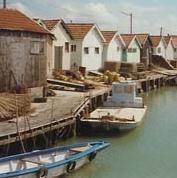 Plate (2)
Plate (2)
The term "plate" also describes a common French oyster
work boat. Inset image: A typical "plate" with shallow-draft
hull and lots of work space on deck. Ideal also for stacking
many "poches" (picture of a plate stacked with poches
here).
Poche
A "poche" is a synthetic
mesh grow out bag for oysters. The "poches", filled
with oysters, are laid out on low steel racks in the tidal zone.
The "rack and bag" cultivation method was invented
in France. Word has it that an enterprising oysterman in Normandy
utilized abandoned field bed frames after WW II as racks in the
tidal zone and placed bags of oysters on them for grow out. "Rack
and bag" is the dominant cultivation method in France. It
is also practiced on a large scale by oyster growers on the U.S.
and Canadian West Coast (on a limited scale on the East Coast
as well). Although the basic concept of the "rack 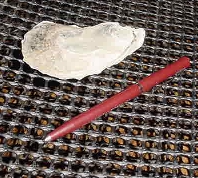 and bag" method
is simple, the proper execution of this cultivation method is
labor intensive and requires quite a bit of know-how. It will
be discussed in detail in the cultivation section of oysters.us
at a later date.
and bag" method
is simple, the proper execution of this cultivation method is
labor intensive and requires quite a bit of know-how. It will
be discussed in detail in the cultivation section of oysters.us
at a later date.
Portugaise
Colloquial name for the Portuguese oyster. Also see "Creuse"
above.
Sauvage
A "sauvage" (a "wild one" or "savage")
designates a very large Pacific oyster. Unlike its counterpart
among the European oysters, the "Pied de Cheval" (see
above), a "sauvage" is quite common and inexpensive
along the coast of France. Although they are too big for slurping
off the half shell, they are nonetheless tasty and tender oysters,
ideally suited for many recipes. You can view some "sauvages"
here . The
"little" oyster in the picture is about 3.5" long.
Table à caire-voie (Tables à
claire-voie surélevées)
"Table a caire-voie" are the low steel racks upon which
mesh bags of oysters (or so called "poches") are placed
fro grow out in the tidal zone. Basic concrete reinforcing bar
(rebar) properly welded together works well and is commonly used.
The bags usually end up sitting on these racks about 20' to 24"
(approx. 50 - 60 cm) above the ground. The length varies - 9
to 10 feet (approx. 3 m) is common.
Trompage
See "Au grand air" above.


